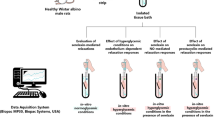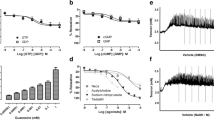Abstract
Objectives
An impairment in the local availability of nitric oxide (NO) may impair male erectile function. The activity of l-arginine-degrading arginase enzymes may attenuate the relaxation of cavernous smooth muscle by reducing local NO production. Arginase enzymes compete with the nitric oxide synthases for the common substrate, the amino acid l-arginine. Very little data are available regarding the significance of arginase enzymes in the control of human penile erectile tissue. The aim of the present study was to elucidate the effects of drugs known to inhibit arginase activity on the relaxation of isolated human corpus cavernosum (HCC) and the production of cyclic GMP.
Methods
Using the organ bath technique, the effects of the arginase inhibitors DFMO, H-Orn-OH·HCl, H-lle-OH and nor-NOHA (10 nM–10 μM) on the tension induced by NE (1 μM) and the relaxation induced by electrical field stimulation (EFS) of HCC were investigated. HCC strips were also exposed to increasing concentrations of the compounds, and the production of cGMP was determined by means of a radioimmunoassay.
Results
Only marginal effects of the arginase inhibitors were registered on the tension induced by NE and the relaxation exerted by EFS. Mean reversion of tension ranged from 18 to 8%. Only DFMO and nor-NOHA amplified the EFS-induced relaxation by 11 and 29%, respectively. These effects were not paralleled by an increase in tissue levels of cGMP.
Conclusion
Arginase inhibitors appeared to be ineffective in reversing the adrenergic tension and increasing the electrically induced relaxation of isolated HCC.



Similar content being viewed by others
References
Andersson KE, Wagner G (1995) Physiology of penile erection. Pharmacol Rev 75:191–236
Kalsi JS, Kell PD (2004) Update on the oral treatments for male erectile dysfunction. Eur Acad Dermatol Venereol 18:267–274. doi:10.1111/j.1468-3083.2004.00885.x
Ückert S, Mayer ME, Stief CG, Jonas U (2007) The future of the oral pharmacotherapy of male erectile dysfunction—things to come. Expert Opin Emerg Drugs 12:219–228. doi:10.1517/14728214.12.2.219
Seidler M, Ückert S, Waldkirch E, Stief CG, Oelke M, Tsikas D, Sohn M, Jonas U (2002) In vitro effects of a novel class of nitric oxide (NO) donating compounds on isolated human erectile tissue. Eur Urol 42:523–528. doi:10.1016/S0302-2838(02)00397-4
Cama E, Colleluori DM, Emig FA, Shin H, Kim SW, Kim NN, Traish AM, Ash DE, Christianson DW (2003) Human arginase II: crystal structure and physiological role in male and female sexual arousal. Biochemistry 22:8445–8451. doi:10.1021/bi034340j
Baggio R, Emig FA, Christianson DW, Ash DE, Chakder S, Rattan S (1999) Biochemical and functional profile of a newly developed potent and isozyme-selective arginase inhibitor. J Pharmacol Exp Ther 290:1409–1416
Masuda H, Yano M, Sakai Y, Kihara K, Yamauchi Y, Azuma H (2004) Modulation of intrinsic cavernous tone and nitric oxide production by arginase in rabbit corpus cavernosum. J Urol 171:490–494. doi:10.1097/01.ju.0000088343.68746.65
Berkowitz DE, White R, Li D, Minhas KM, Cernetich A, Kim S, Burke S, Shoukas AA, Nyhan D, Champion HC, Hare JM (2003) Arginase reciprocally regulates nitric oxide synthase activity and contributes to endothelial dysfunction in aging blood vessels. Circulation 108:2000–2006. doi:10.1161/01.CIR.0000092948.04444.C7
Kim NN, Cox JD, Baggio RF, Emig FA, Mistry SK, Harper SL, Speicher DW, Morris SM Jr, Ash DE, Traish A, Christianson DW (2001) Probing erectile function: S-(2-boronoethyl)-l-cysteine binds to arginase as a transition state analogue and enhances smooth muscle relaxation in human penile corpus cavernosum. Biochemistry 40:2678–2688. doi:10.1021/bi002317h
Hayes JS, Brunton LL (1982) Functional compartments of cyclic nucleotide action. J Cyclic Nucleotide Res 8:1–16
Cox JD, Kim NN, Traish AM, Christianson DW (1999) Arginase-boronic acid complex highlights a physiological role in erectile function. Nat Struct Biol 6:1043–1047. doi:10.1038/14929
Bivalacqua TJ, Hellstrom WJ, Kadowitz PJ, Champion HC (2001) Increased expression of arginase II in human diabetic corpus cavernosum: in diabetic-associated erectile dysfunction. Biochem Biophys Res Commun 283:923–927. doi:10.1006/bbrc.2001.4874
Conflict of interest statement
There is no conflict of interest.
Author information
Authors and Affiliations
Corresponding author
Rights and permissions
About this article
Cite this article
Lorenzen, J.M., Ückert, S., Scheller, F. et al. Effects of arginase inhibitors on the contractile and relaxant responses of isolated human penile erectile tissue. World J Urol 27, 805–810 (2009). https://doi.org/10.1007/s00345-009-0405-1
Received:
Accepted:
Published:
Issue Date:
DOI: https://doi.org/10.1007/s00345-009-0405-1




